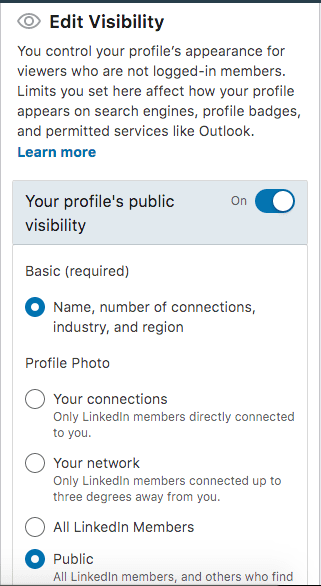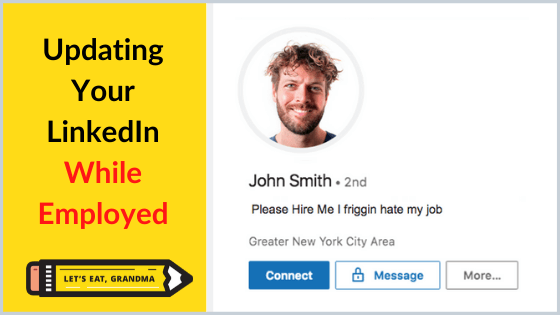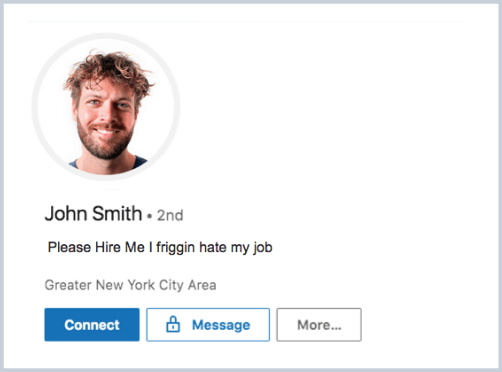Sometimes you need to fly under the radar. Here’s everything you need to know about using LinkedIn to find a job while employed.
By: Chris Villanueva, CPRW and Founder of Let’s Eat, Grandma
Many job seekers come to Let’s Eat, Grandma wanting to update their LinkedIn profile, but afraid of what their bosses will think if they see changes.
Not to fear! There is an easy way to do this without having to fear an awkward-boss-scenario.
First things first – LinkedIn is an amazing tool to find a job, but you need to carefully determine how you should use it to conduct your job search while you’re employed. Use your best judgment based on how intensely your employer monitors their employees’ social media presence.
If your boss is straight-up from George Orwell’s 1984 and checks your LinkedIn daily for even the slightest activity, then perhaps you should prioritize another method for your job search (or just quit that job now).
Here’s our stand on using LinkedIn to find a job while employed:
Use discretion. Make the profile as attractive as possible without overtly claiming you are looking for a job.
So don’t look like this guy:
(Don’t worry, we made this profile up.)
All jokes aside, here are three considerations for updating LinkedIn when employed:
Using Linkedin To Find a Job While Employed: 3 Considerations
1.) As long as you don’t claim you are trying to find a job on your profile, you should be fine.
Look, there’s nothing wrong with having a good-looking LinkedIn profile.
Unless your boss is like an evil overlord or a possessive partner, they’re not likely to notice anything suspicious in your updates. As long as they aren’t taking screenshots of your profile and playing detective on a weekly basis, you should be fine.
So go right ahead:
- Get a brand new headshot.
- Flesh out your LinkedIn Summary and professional experiences to showcase those accomplishments.
- Add some skills that you’ve picked up at your most recent job.
- Make more connections!
There are so many ways to make your LinkedIn work for you that are not going to be red flags for your current employer.
However, it is possible to accidentally give your employer a tip that you are job searching.
Here are some extra precautions to take:
Use the “Career Interests” section at your own risk.
The Career Interests section is a great way to get extra visibility for your job search. You can notify recruiters who are actively looking for candidates that you are fair game for hiring.
We recommend turning on the “Let recruiters know you’re open” option only in certain cases.
LinkedIn takes steps to keep your job search private, but they do not make any guarantees for complete privacy. This means that when you turn this option on, it is unlikely but still possible that recruiters from your own company could find you as a job seeker.
So, don’t be afraid of turning this option on if you know that your hiring department doesn’t use LinkedIn at all, or if you wouldn’t mind being found by a recruiter. (I.e, if you already have some leads and wouldn’t mind putting in your two weeks’ notice in the rare case you’re discovered.)
And, of course, if your boss already knows you’re looking for a job, then no worries!
If those circumstances don’t apply to you, though, turn this option on at your own risk. You may be better off focusing on contacting recruiters directly.
Don’t mention that you are looking for a job online—or at work.
This one seems pretty obvious, but you have to remove any mention of looking for a job out of your profile. Don’t state anywhere in your headline or summary that you’re “open to new opportunities” or “seeking a fulfilling position in [Industry.]”
Also, don’t mention to anyone at work that you are looking for a new job (even those who complain with you). Don’t give your boss a reason to be paranoid. Rumors start, and then you may find your employer looking closely at your LinkedIn.
Consider keeping your employer in your LinkedIn headline.
The LinkedIn headline is a great opportunity to show prospective employers who you are as a professional while capturing those coveted keywords.
I usually don’t recommend keeping your employer in your headline. But if you want to tide off any suspicion by “showing loyalty,” then consider leaving it in there with some additions.
In the example above, Alex Hisaka, Head of Content Marketing at LinkedIn, chose to keep her title in her headline (for a good reason). We like this headline because it also has her brand statement (“Transforming the way people do business through content”).
2.) Your employer may see your new LinkedIn profile as a good thing.
Can anything good come from your employer looking at a fresh new LinkedIn profile?
Of course!
Your employer may even value you more if they previously had not. Perhaps you think that’s a stretch, but put yourself in the perspective of an employer for a second.
Imagine this: you have a valuable employee who believes in their skills enough to present a good professional profile of themself to the public. Is that the worst thing in the world? Heck no!
Part of having a good LinkedIn is describing how much you kill it at your current job, after all. They might even look at your profile and say, “gee, maybe this is a person that we need to keep…”
“But my boss doesn’t think like that,” you may say. “They would see a lot of updates and think I am going to leave. And then they would fire me.”
If they really do think that, then you should leave. It’s self-fulfilling prophecy at its finest. Don’t settle for a job you hate, people.
One more scenario: Your company has some prospective customers doing their research, and they dig around to see what members at the organization are like (something they can easily do on LinkedIn). Your company will want you to represent them well with a good profile, especially if you are in a higher position or if your organization is small.
Remember this: LinkedIn is not just for job seekers. It’s an overall professional platform that helps people remain connected within a business context.
If your boss ever says anything about your new profile, you can instantly bring that up in conversation. “I just want to make sure that I continue to represent this company well with my online image“… is an easy response to any raised eyebrows.
3.) Consider making your LinkedIn profile private to only your network.

If you are truly worried about your employer seeing your LinkedIn changes, you can always make your profile private to your network.
(This obviously does not help if you are connected with your boss on LinkedIn).
With this approach, you would need to rely solely on your networking game. You’ll need to connect with as many people as possible on LinkedIn, directly contact recruiters, and hope that they all look at your profile. Given that you want to stay active in your network on LinkedIn to find a job anyway, this isn’t the worst thing.
The disadvantage here, though, is that recruiters searching for candidates won’t be able to find your profile. A recruiter who views your resume also could not look you up on LinkedIn after seeing how great you look on your resume.
We hope this article quelled your fears about using LinkedIn to find a job while employed. Start making improvements to your LinkedIn profile, and don’t worry too much about your boss finding out!
Any questions, or anything we missed? Comment below, or get in touch with us directly here.





